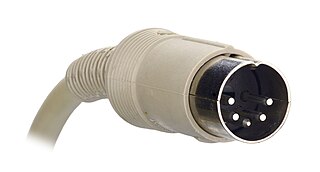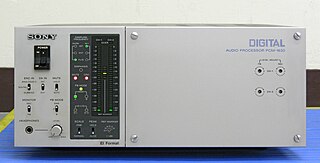
A boombox is a transistorized portable music player featuring one or two cassette tape players/recorders and AM/FM radio, generally with a carrying handle. Beginning in the mid-1990s, a CD player was often included. Sound is delivered through an amplifier and two or more integrated loudspeakers. A boombox is a device typically capable of receiving radio stations and playing recorded music. Many models are also capable of recording onto cassette tapes from radio and other sources. In the 1990s, some boomboxes were available with MiniDisc recorders and players. Designed for portability, boomboxes can be powered by batteries as well as by line current. The boombox was introduced to the American market during the late 1970s. The desire for louder and heavier bass led to bigger and heavier boxes; by the 1980s, some boomboxes had reached the size of a suitcase. Some larger boomboxes even contained vertically mounted record turntables. Most boomboxes were battery-operated, leading to extremely heavy, bulky boxes.
A hard disk recorder (HDR) is a system that uses a high-capacity hard disk to record digital audio or digital video. Hard disk recording systems represent an alternative to reel-to-reel audio tape recording and video tape recorders, and provide non-linear editing capabilities unavailable using tape recorders. Audio HDR systems, which can be standalone or computer-based, are typically combined with provisions for digital mixing and processing of the audio signal to produce a digital audio workstation (DAW).

Nagra is a brand of portable audio recorders produced from 1951 in Switzerland. Beginning in 1997 a range of high-end equipment aimed at the audiophile community was introduced, and Nagra expanded the company's product lines into new markets.

Ampex Data Systems Corporation is an American electronics company founded in 1944 by Alexander M. Poniatoff as a spin-off of Dalmo-Victor. The name AMPEX is an acronym, created by its founder, which stands for Alexander M. Poniatoff Excellence. Ampex operates as Ampex Data Systems Corporation, a subsidiary of Delta Information Systems, and consists of two business units. The Silicon Valley unit, known internally as Ampex Data Systems (ADS), manufactures digital data storage systems capable of functioning in harsh environments. The Colorado Springs, Colorado, unit, referred to as Ampex Intelligent Systems (AIS), serves as a laboratory and hub for the company's line of industrial control systems, cyber security products and services and its artificial intelligence/machine learning technology.

Digital Compact Cassette (DCC) is a magnetic tape sound recording format introduced by Philips and Matsushita Electric in late 1992 and marketed as the successor to the standard analog Compact Cassette. It was also a direct competitor to Sony's MiniDisc (MD), but neither format toppled the then-ubiquitous analog cassette despite their technical superiority, and DCC was discontinued in October 1996. Another competing format, the Digital Audio Tape (DAT), had by 1992 also failed to sell in large quantities to consumers, although it was popular as a professional digital audio storage format.

A camcorder is a self-contained portable electronic device with video and recording as its primary function. It is typically equipped with an articulating screen mounted on the left side, a belt to facilitate holding on the right side, hot-swappable battery facing towards the user, hot-swappable recording media, and an internally contained quiet optical zoom lens.

The DIN connector is an electrical connector that was standardized by the Deutsches Institut für Normung (DIN), the German Institute for Standards, in the mid 1950s, initially with 3 pins for mono, but when stereo connections and gear appeared in late 1950s, versions with 5 pins or more were launched. The male DIN connectors (plugs) feature a 13.2 mm diameter metal shield with a notch that limits the orientation in which plug and socket can mate. The range of DIN connectors, different only in the configuration of the pins, have been standardized as DIN 41524 / IEC/DIN EN 60130-9 ; DIN 45322 ; DIN 45329 / IEC/DIN EN 60130–9 ; and DIN 45326 / IEC/DIN EN 60130-9.
A digital video recorder (DVR), also referred to as a personal video recorder (PVR) particularly in Canada and British English, is an electronic device that records video in a digital format to a disk drive, USB flash drive, SD memory card, SSD or other local or networked mass storage device. The term includes set-top boxes (STB) with direct to disk recording, portable media players and TV gateways with recording capability, and digital camcorders. Personal computers are often connected to video capture devices and used as DVRs; in such cases the application software used to record video is an integral part of the DVR. Many DVRs are classified as consumer electronic devices. Similar small devices with built-in displays and SSD support may be used for professional film or video production, as these recorders often do not have the limitations that built-in recorders in cameras have, offering wider codec support, the removal of recording time limitations and higher bitrates.

HDV is a format for recording of high-definition video on DV videocassette tape. The format was originally developed by JVC and supported by Sony, Canon, and Sharp. The four companies formed the HDV Consortium in September 2003.
Marantz is a company that develops and sells high-end audio products. The company was founded in New York, but is now based in California.

D-VHS is a digital video recording format developed by JVC, in collaboration with Hitachi, Matsushita, and Philips. The "D" in D-VHS originally stood for "Data", but JVC renamed the format as "Digital VHS". Released in December 1997, it uses the same physical cassette format and recording mechanism as S-VHS, but requires higher-quality and more expensive tapes and is capable of recording and displaying both standard-definition and high-definition content. The content data format is in MPEG transport stream, the same data format used for most digital television applications. It used MPEG-2 encoding and was standarized as IEC 60774-5.

A PCM adaptor is a device that encodes digital audio as video for recording on a videocassette recorder. The adapter also has the ability to decode a video signal back to digital audio for playback. This digital audio system was used for mastering early compact discs.

The TASCAM Portastudio was the first four-track recorder based on a standard compact audio cassette tape. The term portastudio is exclusive to TASCAM, though it is generally used to describe all self-contained cassette-based multitrack recorders dedicated to music production. The Portastudio, and particularly its first iteration, the Teac 144, is credited with launching the home-recording wave, which allowed musicians to cheaply record and produce music at home, and is cited as one of the most significant innovations in music production technology.
Soundstream Inc. was the first United States audiophile digital audio recording company, providing commercial services for recording and computer-based editing.
Foster Denki KK is an electronics company that manufactures loudspeakers and audio equipment for other companies or sells them under the trade name Fostex. It is traded on the Tokyo Stock Exchange.

The H4 Handy Recorder is a handheld digital audio recorder from Zoom, featuring built-in condenser microphones in an X-Y stereo pattern, priced from around US$280 depending upon memory capacity as of 2011.

The H2 Handy Recorder is a handheld digital audio recorder from Zoom first announced at the NAMM Show in February 2007. It records very high quality digital stereo or 4-channel audio on a hand-held unit, and has been called "the studio on a stick."

Magnum Opus is the only studio album by American rapper Top Quality. It was released on May 24, 1994, though RCA Records. Recording sessions took place at Black Zone Studio in Long Island, Fingers Studio and Platinum Island Studios in New York City. Production was handled by Charlie Marotta, Jesse West, Black Zone, Hell Raisin, John Hall, Keivan Mack, Kevin A. Pyatt, Solid Scheme and Tray Bag, with PMD serving as executive producer.
From 1963 to 1970, Ampex manufactured several models of VTR 2-inch helical VTRs, capable of recording and playing back analog black and white video. Recording employed non-segmented helical scanning, with one wrap of the tape around the video head drum being a little more than 180 degrees, using two video heads. One video drum rotation time was two fields of video. The units had two audio tracks recorded on the top edge of the tape, with a control track recorded on the tape's bottom edge. The 2-inch-wide video tape used was one mil thick. The VTRs were mostly used by industrial companies, educational institutions, and a few for in-flight entertainment.
Rumbo Recorders was a recording studio in the Canoga Park neighborhood of Los Angeles, California.